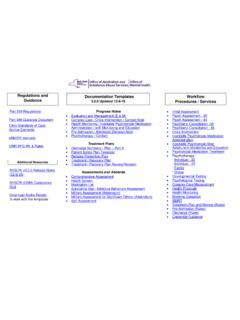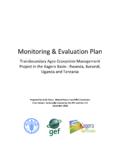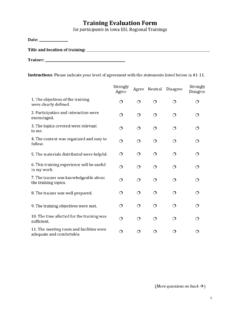Transcription of Developing an Effective Evaluation Plan
1 Developing an Effective Evaluation plan Setting the course for Effective program evaluationAcknowledgmentsThis workbook was developed by the Centers for Disease Control and Prevention s (CDC s) Office on Smoking and Health (OSH) and Division of Nutrition, Physical Activity, and Obesity (DNPAO). This workbook was developed as part of a series of technical assistance workbooks for use by program managers, and evaluators. The workbooks are intended to offer guidance and facilitate capacity building on a wide range of Evaluation topics. We encourage users to adapt the tools and resources in this workbook to meet their program s Evaluation workbook applies the CDC Framework for Program Evaluation in Public Health ( ). The Framework lays out a six-step process for the decisions and activities involved in conducting an Evaluation .
2 While the Framework provides steps for program Evaluation , the steps are not always linear and represent a more back-and-forth effort; some can be completed concurrently. In some cases, it makes more sense to skip a step and come back to it. The important thing is that the steps are considered within the specific context of your Citation: Developing an Effective Evaluation plan . Atlanta, Georgia: Centers for Disease Control and Prevention, National Center for Chronic Disease Prevention and Health Promotion, Office on Smoking and Health; Division of Nutrition, Physical Activity, and Obesity, of ContentsPart I: Developing Your Evaluation plan ..1 Who is the audience for this workbook? ..1 What is an Evaluation plan ? ..1 Why do you want an Evaluation plan ?
3 2 How do you write an Evaluation plan ? ..3 What are the key steps in Developing an Evaluation plan using CDC s Framework for Program Evaluation ? ..4 The Process of Participatory Evaluation Planning ..6 Step 1: Engage Stakeholders ..6 Defining the Purpose in the plan ..6 The ESW: Why should you engage stakeholders in Developing the Evaluation plan ? ..7 Who are the program s stakeholders? ..8 How do you use an ESW to develop an Evaluation plan ?..8 How are stakeholder s roles described in the plan ? ..9 Step 2: Describe the Program ..12 Shared Understanding of the Program ..12 Narrative Description ..12 Logic Model ..13 Stage of Development ..14 Step 3: Focus the Evaluation ..18 Developing Evaluation Questions ..19 Budget and Resources.
4 21 Step 4: Planning for Gathering Credible Evidence ..23 Choosing the Appropriate Methods ..24 Credible Evidence ..25 Measurement ..25 Data Sources and Methods ..26 Roles and Responsibilities ..27 Evaluation plan Methods Grid ..27 Budget ..28 Step 5: Planning for Conclusions ..30 Step 6: Planning for Dissemination and Sharing of Lessons Learned ..33 Communication and Dissemination Plans ..34 Ensuring Use ..37 One Last Note ..37 Pulling It All Together .. II: Exercise, Worksheets, and Tools ..44 Step 1: Stakeholder Mapping Exercise ..45 Step 1: Evaluation Purpose Exercise ..50 Step 1: Stakeholder Inclusion and Communication plan Exercise ..53 Step 1: Stakeholder Information Needs Exercise ..55 Step 2: Program Stage of Development Exercise.
5 57 Step 3: Focus the Evaluation Exercise ..62 Step 4: Evaluation plan Methods Grid Exercise ..68 Step 4: Evaluation Budget Exercise ..73 Step 5: Stakeholder Interpretation Meeting 6: Reporting Checklist Exercise ..80 Tools and Templates: Checklist for Ensuring Effective Evaluation 6: Communicating Results Exercise ..82 Outline: Basic Elements of an Evaluation plan ..88 Outline: Evaluation plan Sketchpad ..88 Logic Model Examples ..98 OSH Logic Models Example ..98 Preventing Initiation of Tobacco Use Among Young People ..98 Eliminating Nonsmokers Exposure to Secondhand Smoke ..99 Promoting Quitting Among Adults and Young People ..100 DNPAO Logic Model Example ..101 State NPAO Program Detailed Logic Model ..101 Resources.
6 102 Web Resources ..102 Making your ideas stick, reporting, and program planning ..104 Qualitative Methods ..104 Quantitative Methods ..105 Evaluation Use ..105 OSH Evaluation Resources ..105 DNPAO Evaluation Resources ..108 FiguresFigure 1: CDC Framework for Program Evaluation in Public Health ..5 Figure 2: Sample Logic Model ..13 Figure : Stage of Development by Logic Model Category ..15 Figure : Stage of Development by Logic Model Category Example ..15 Figure : Evaluation plan Methods Grid Example ..27 Figure : Evaluation plan Methods Grid Example ..28 Figure 5: Communication plan Table ..36 AcronymsBRFSS Behavioral Risk Factor Surveillance System CDC Centers for Disease Control and Prevention DNPAO Division of Nutrition, Physical Activity, and Obesity ESW Evaluation Stakeholder Workgroup NIDRR National Institute on Disability and Rehabilitation Research OSH Office on Smoking and Health PRAMS Pregnancy Risk Assessment Monitoring SystemYRBS Youth Risk Behavior Surveillance Part I: Developing Your Evaluation PlanWHO IS THE AUDIENCE FOR THIS WORKBOOK?
7 The purpose of this workbook is to help public health program managers, administrators, and evaluators develop a joint understanding of what constitutes an Evaluation plan , why it is important, and how to develop an Effective Evaluation plan in the context of the planning process. This workbook is intended to assist in Developing an Evaluation plan but is not intended to serve as a complete resource on how to implement program Evaluation . Rather, it is intended to be used along with other Evaluation resources, such as those listed in the Resource Section of this workbook. The workbook was written by the staff of the Office on Smoking and Health (OSH) and the Division of Nutrition, Physical Activity, and Obesity (DNPAO) at the Centers for Disease Control and Prevention (CDC).
8 However, the content and steps for writing an Evaluation plan can be applied to any public health program or initiative. Part I of this workbook defines and describes how to write an Effective Evaluation plan . Part II of this workbook includes exercises, worksheets, tools, and a Resource Section to facilitate program staff and Evaluation stakeholder workgroup (ESW) thinking through the concepts presented in Part I of this workbook. WHAT IS AN Evaluation plan ?An Evaluation plan is a written document that describes how you will monitor and evaluate your program, as well as how you intend to use Evaluation results for program improvement and decision making. The Evaluation plan clarifies how you will describe the What, the How, and the Why It Matters for your program.
9 The What reflects the description of your program and how its activities are linked with the intended effects. It serves to clarify the program s purpose and anticipated outcomes. The How addresses the process for implementing a program and provides information about whether the program is operating with fidelity to the program s design. Additionally, the How (or process Evaluation ), along with output and/or short-term outcome information, helps clarify if changes should be made during implementation. An Evaluation plan is a written document that describes how you will monitor and evaluate your program, so that you will be able to describe the What , the How , and the Why It Matters for your program and use Evaluation results for program improvement and decision | Developing an Effective Evaluation plan The Why It Matters provides the rationale for your program and the impact it has on public health.
10 This is also sometimes referred to as the so what question. Being able to demonstrate that your program has made a difference is critical to program sustainability. An Evaluation plan is similar to a roadmap. It clarifies the steps needed to assess the processes and outcomes of a program. An Effective Evaluation plan is more than a column of indicators added to your program s work plan . It is a dynamic tool ( , a living document ) that should be updated on an ongoing basis to reflect program changes and priorities over time. An Evaluation plan serves as a bridge between Evaluation and program planning by highlighting program goals, clarifying measurable program objectives, and linking program activities with intended outcomes. WHY DO YOU WANT AN Evaluation plan ?














